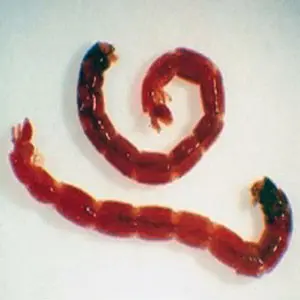Bloodworms are the best food for aquarium fish. These are tiny red worms that thrive in the mud of lakes and rivers. To find bloodworms, the mud is sifted through a mesh. In cities, they can be purchased at specialized pet stores. Fish are typically fed 5-6 bloodworms daily, and it’s best to toss them into the water all at once rather than one by one, allowing all the fish to grab them simultaneously. It’s advisable not to drop them to the bottom, as they quickly bury themselves in the sand; instead, place them on a small white dish set at the bottom. Before feeding bloodworms to the fish, they should be rinsed in water to remove any debris and impurities.
Earthworms are also a good food source for fish. However, it’s not recommended to feed fish only earthworms for an extended period, as they can become quite fatty. Earthworms can be harvested and stored for winter. To do this, layers of soil and fallen leaves are placed in a box, alternating with sand on top. You can also add pieces of turf, layering them with manure. For every bucket of this mixture, about a hundred worms should be added. Every two weeks, a few boiled potatoes should be buried in the box.
Fish also enjoy semolina porridge cooked in water. To prepare it, use the standard method: for one cup of water, take a quarter cup of semolina. Once the water with the semolina comes to a boil, strain the porridge through a fine sieve and rinse it with cold water until the water draining from the sieve runs clear. This method ensures that the grains of semolina are separated from each other.
You can also feed fish buckwheat porridge, prepared in a way that keeps the grains loose.
In winter, dried daphnia is often fed to fish. Dried daphnia should be given in small amounts, and it’s better to scald them with boiling water beforehand. Instead of tossing them into the aquarium, they should be gently placed on the water’s surface.

